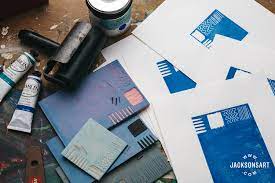Using vinyl sheets, artists may express their imagination and create stunning works of art on a wide variety of surfaces. Because of its adaptability and one-of-a-kind outcomes, this dynamic approach has seen explosive growth in popularity among both working artists and dedicated amateurs. This essay will go into the world of vinyl printmaking, examining its processes, uses, benefits, and the delight it offers to artists and art enthusiasts.
Introduction to Vinyl Printmaking
Artists who work with vinyl printing create detailed patterns on vinyl sheets, which are subsequently transferred to a variety of substrates through a series of steps that include cutting, weeding, and transferring. This technique opens up a whole new world of possibilities for creative expression, allowing artists to realize their visions with greater precision and originality.
Tools and Materials You’ll Need
It’s important to get all your supplies together before you start manufacturing vinyl prints. You’ll need any surface you plan to print on in addition to vinyl sheets, cutting machines, weeding tools, transfer tape, and ink. The correct equipment may make the creative process easier and more pleasurable for anybody, from novices to seasoned pros.
Step-by-Step Guide to Vinyl Printmaking
Preparing Your Design
To get started on your artwork, consider using a digital medium for its conception and design. Your vinyl print will be based on this design. Strike a balance between intricacy and manageability, keeping in mind that ornate and detailed designs might be difficult to trim and weed.
Cutting the Vinyl
Put your design onto the vinyl sheet using the cutting machine. Every last element of the design is preserved when the machine carefully cuts it out.
Weeding the Design
Using weeding tools, carefully cut away the extra vinyl surrounding your design. To preserve the integrity of the final design during this procedure, patience and accuracy are required.
Applying Transfer Tape
After your pattern has been weeded, carefully apply transfer tape and press down firmly. The vinyl decal is kept in place by the transfer tape until it is ready to be transferred.
Transferring the Design
Place the transfer tape onto the surface you intend to decorate with the vinyl design. Make sure there are no air bubbles by pressing gently. Remove the transfer tape slowly so that the vinyl pattern doesn’t come off with it.
Exploring Different Surfaces for Printmaking
Vinyl printing may be done on any surface. Artists are free to try out a wide range of surfaces while making prints in order to find the optimal one for each use.
Fabric Printing
Use vinyl prints to personalize your wardrobe and other textiles. Vinyl printing brings a certain flair to all sorts of textile projects, from t-shirts to tote bags.
Paper and Stationery Printing
Create one-of-a-kind art prints, cards, and invitations with vinyl. Vinyl’s textural character enriches paper-based creations with a new dimension of aesthetic intrigue.
Glass and Ceramic Printing
Vinyl decals may be used to add a touch of class to your favorite cups, plates, and platters. These prints are great as house décor or presents because of their versatility.
Benefits of Vinyl Printmaking
Precision and Detail
With vinyl printing, you can be sure that every line and curve will be reproduced faithfully in the final print.
Customization and Reproducibility
Artists may make changes to their designs and print several copies with no noticeable difference in quality, making this method ideal for one-of-a-kind keepsakes and artworks.
Texture and Dimension
Prints benefit from vinyl’s textural and dimensional additions, which increase their visual appeal.
Incorporating Vinyl Print into Mixed Media Art
Vinyl prints are a versatile medium that may be used in conjunction with other mediums to create multi-layered works of art by mixed media artists.
Vinyl Printmaking Workshops: Learning and Creating Together
Participating in vinyl printing workshops is a great way to gain practical skills and make connections with other creatives. Techniques, designs, and troubleshooting are all covered in detail throughout these sessions.
Preserving and Displaying Your Vinyl Prints
Framing and Mounting Options
Vinyl prints can be framed to prevent them from being damaged by dust and dirt. Select frames that go well with the decor of the room in which the artwork will be exhibited.
Caring for Your Prints
Vinyl prints may last for a long time and maintain their vivid colours with the right care, such as avoiding exposure to direct sunlight and moisture.
The Growing Popularity of Vinyl Art in Home Decor
Vinyl prints are increasingly becoming a go-to choice for home decor. Their versatility and ability to transform living spaces have captured the interest of interior designers and homeowners alike.
Challenges and How to Overcome Them
Mastering the Cutting Techniques
It takes practise to make cuts that are both clean and accurate. Find the optimal blade setting and cutting speed for your vinyl type and design through trial and error.
Dealing with Intricate Designs
Weeding and transferring intricate patterns requires patience and attention. Use instruments designed to prevent damage while handling fragile objects, and take your time.
Vinyl Printmaking as a Business Venture
Creating Custom Designs for Clients
It’s possible to earn a profit by advertising print jobs on vinyl. Working together, you may make something truly special for your customers.
Selling Limited Edition Prints
Vinyl print runs can be numbered and signed by the artist, making each print a collectible. Selling prints to art buyers is one way to build a steady revenue stream.
The Future of Vinyl Printmaking: Innovation and Trends
The potentials of vinyl printing expand together with the development of new technologies. To improve their works even more, artists may look forward to trying out novel mediums, processes, and digital resources.
Inspiration from Prominent Vinyl Print Artists
Learn from the experts who have perfected the vinyl printmaking process. Their one-of-a-kind.
Conclusion
In conclusion, vinyl printing provides an alluring platform for artists to express their individuality and create works of lasting beauty and significance. This adaptable method has made its way into many forms of art, enriching anything from clothes and paper to glass and ceramics with elaborate patterns and textured prints. Vinyl printing is a useful technique because of its accuracy, adaptability, and three-dimensionality.
Frequently Asked Questions
1. Is vinyl printmaking suitable for beginners?
Absolutely! Any artist may learn the skills necessary to create vinyl prints. Beginning designers might improve their abilities by practising on basic projects first.
2. Can I use vinyl prints for outdoor decorations?
Vinyl prints are sturdy, but they won’t last forever if left outside in the rain and snow. Use vinyl that is resistant to ultraviolet light and provides some shelter from the elements.
3. Is special software needed for designing vinyl prints.
Indeed, design software is necessary for making digital designs for vinyl cutting. Adobe Illustrator and CorelDRAW are two popular options for this kind of work.





